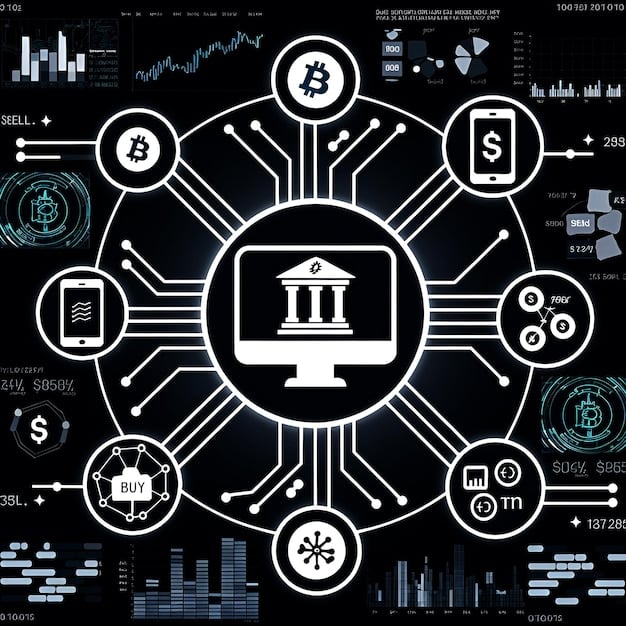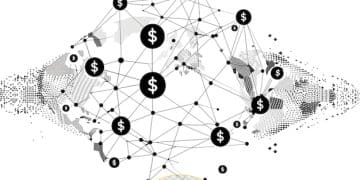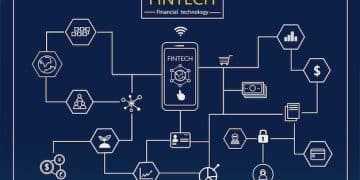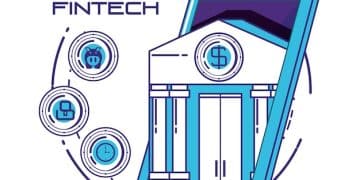Open Banking APIs to Redefine US Personal Finance by 2025

By 2025, Open Banking APIs will fundamentally redefine personal finance management in the US by empowering consumers with greater control over their financial data, fostering innovation in financial products, and increasing competition among service providers, leading to more personalized and efficient money management solutions.
The financial landscape in the United States is on the cusp of an unparalleled transformation. Driven by technological advancements and evolving consumer demands, the advent of Open Banking APIs will redefine personal finance management in the US by 2025. This shift promises to empower individuals with unprecedented control over their financial data, fostering an ecosystem where personalized and efficient money management solutions are not just a luxury but a standard expectation.
The Foundational Shift: Understanding Open Banking APIs
Open Banking, while a well-established concept in Europe and other regions, is rapidly gaining traction in the US. At its core, it enables secure and permission-based sharing of financial data between banks and authorized third-party providers through Application Programming Interfaces (APIs). This isn’t just a technical upgrade; it represents a paradigm shift from traditional, closed banking systems to an interconnected, data-driven financial ecosystem.
For individuals, this means moving beyond the siloed view of their finances. Imagine a world where your checking account, savings, investments, and loan data, across multiple institutions, can be aggregated and analyzed by a single, trusted application of your choosing. This interconnectedness fuels a new era of proactive and holistic financial management, breaking down the barriers that have historically fragmented our financial lives.
What are Open Banking APIs?
Open Banking APIs are the secure digital bridges that allow different financial institutions and authorized third-party applications to communicate and share specific customer data with explicit consent. This secure data exchange creates a dynamic environment where consumers can grant access to their financial information to innovative apps that help them budget, save, invest, and even apply for loans more efficiently.
Historically, accessing comprehensive financial data meant logging into multiple platforms, downloading statements, and manually inputting information into budgeting tools. Open Banking APIs automate this process, ensuring data accuracy and real-time updates. This not only saves time but also provides a more current and complete picture of an individual’s financial health, enabling better decision-making.
- Secure Data Sharing: APIs ensure that data is encrypted and transferred through secure channels, with the user always in control.
- Consent-Driven Access: Users must explicitly grant and manage permissions for third-party access to their financial data.
- Standardized Communication: APIs create a common language for financial systems to interact, regardless of their underlying technology.
The transition to an Open Banking framework in the US by 2025 is not merely about convenience; it’s about shifting power to the consumer. It compels traditional banks to innovate and collaborate, ensuring they remain relevant in a market increasingly dominated by agile fintechs. For the average American, this translates into more choice, better products, and a financial experience tailored to their unique needs.
Enhanced Personalization: Tailoring Financial Experiences
One of the most profound impacts of Open Banking APIs on personal finance in the US will be the unprecedented level of personalization they enable. With secure access to a consolidated view of a user’s financial data, fintech applications and traditional banks alike can offer truly bespoke services. This moves beyond generic advice to actionable insights based on individual spending habits, income patterns, and financial goals.
Imagine a budgeting app that not only tracks your expenses but actively helps you find cheaper insurance, monitors your subscription services, and identifies opportunities to save based on your actual transaction history, all without manual input. This level of granular insight transforms personal finance from a reactive chore into a proactive, intelligent partnership.
Proactive Financial Advice and Tools
The ability to aggregate and analyze data from various sources means that financial tools can become far more intelligent and predictive. Instead of just showing past spending, they can forecast future cash flow, warn of potential shortfalls, and recommend timely actions. This proactive approach helps users avoid financial pitfalls and seize opportunities they might otherwise miss.
- Budgeting Automation: Automated categorization of expenses and intelligent recommendations for spending adjustments.
- Personalized Savings Goals: Tools that analyze income and spending to suggest achievable savings targets and automated transfers.
- Optimized Debt Management: Recommendations for debt consolidation or accelerated repayment strategies based on current financial standing.
- Tailored Investment Opportunities: Matching investment products to individual risk profiles and financial aspirations.
This personalization extends beyond simple budgeting. It encompasses the entire spectrum of financial decision-making, from selecting the right credit card to planning for retirement. By 2025, we can expect a new generation of financial advisors—both human and AI-powered—who leverage Open Banking data to provide holistic and highly relevant guidance, making sophisticated financial planning accessible to a broader audience.

Increased Competition and Innovation in Financial Services
The open access paradigm introduced by Open Banking APIs is set to ignite a fierce wave of competition and innovation within the US financial sector. By leveling the playing field for fintech startups and empowering consumers to switch providers more easily, Open Banking dismantles traditional barriers to entry and incentivizes all players to deliver superior value. Traditional banks, once beneficiaries of data monopolies, will be compelled to innovate or risk losing market share to more agile, customer-centric challengers.
This dynamic environment will accelerate the development of novel financial products and services. Expect a surge in specialized apps designed to address niche financial needs, from personalized credit building tools to micro-investment platforms that cater to specific ethical or social values. The power of choice will firmly rest with the consumer, pushing providers toward transparency and excellence.
New Product Development and Fintech Growth
Open Banking APIs act as an accelerant for fintech innovation. Startups can now build compelling applications without needing to establish direct, cumbersome integrations with hundreds of individual banks. This significantly reduces development time and costs, allowing them to focus on creating value for the end-user. We’ll see an explosion of niche services and integrated platforms.
This ease of integration fosters a diverse ecosystem where companies can specialize in specific aspects of personal finance. Imagine a tool that focuses solely on optimizing your subscription spending, or an app dedicated to helping you manage irregular income streams effectively. Such specialized solutions, powered by granular data access, will address previously unmet consumer needs.
Furthermore, this competition isn’t limited to external fintechs. Traditional banks are also embracing Open Banking, recognizing it as an opportunity to modernize their offerings and enhance customer loyalty. By leveraging their own APIs, some banks are fostering internal innovation teams or partnering with fintechs to integrate cutting-edge features directly into their existing platforms, leading to a hybrid model that benefits consumers.
Empowering Financial Inclusion and Accessibility
Beyond convenience and personalization, Open Banking APIs hold significant potential to enhance financial inclusion and accessibility for underserved populations in the US. By providing a more comprehensive and real-time view of an individual’s financial behavior, these APIs can help overcome traditional barriers to credit and financial services for those with limited credit history or unconventional income streams.
Many traditional financial systems rely heavily on historical credit scores that may not accurately reflect an individual’s current financial health or responsibility. Open Banking allows lenders and service providers to access a broader range of data, such as utility bill payments, rent history, and steady income over time, painting a more complete picture of creditworthiness. This broader data set can unlock opportunities for individuals previously excluded from mainstream financial products.
Overcoming Traditional Credit Barriers
For millions of Americans, especially those who are new to the financial system, immigrants, or individuals with volatile incomes, obtaining credit or even a basic bank account can be a significant challenge. Open Banking can mitigate this by offering alternative data points for assessment. This includes:
- Transaction History: Demonstrating consistent income and responsible spending, even without a formal credit score.
- Bill Payment Patterns: Verifying on-time payments for utilities, rent, and other regular expenses.
- Cash Flow Analysis: Providing lenders with a real-time understanding of an applicant’s ability to manage funds.
By 2025, as Open Banking becomes more ubiquitous, we anticipate a reduction in systemic biases inherent in older credit assessment models. This could lead to more equitable access to loans, mortgages, and other essential financial services, fostering economic empowerment across diverse communities. The ability for fintechs to identify and serve these previously marginalized segments creates new market opportunities while simultaneously addressing critical social needs.

Security and Privacy: The Paramount Concerns
While the benefits of Open Banking APIs are immense, the conversation around their adoption in the US must also critically address the paramount concerns of security and privacy. The secure transmission and storage of sensitive financial data are non-negotiable. For Open Banking to truly thrive and gain widespread consumer trust by 2025, robust regulatory frameworks, advanced encryption technologies, and transparent user controls must be firmly in place.
A single data breach or misuse of information could severely undermine public confidence, hindering the progress of this transformative technology. Therefore, the development and implementation of Open Banking solutions are inextricably linked to ensuring the highest standards of data protection and individual privacy rights.
Protecting Consumer Data
The architecture of Open Banking APIs is inherently designed with security in mind, employing state-of-the-art encryption, multi-factor authentication, and strict access protocols. However, the responsibility extends to all participants in the ecosystem – banks, fintechs, and regulators. Consumers must always have clear visibility and granular control over which data is shared, with whom, and for how long.
- Consent Management: Users must easily grant, modify, or revoke consent for data sharing at any time.
- Robust Encryption: All data in transit and at rest must be protected with industry-leading encryption standards.
- Regulatory Oversight: Clear government regulations (like those being considered by the CFPB) are crucial for enforcing data protection and accountability.
- Regular Audits: Third-party providers and banks must undergo regular security audits to ensure compliance and identify vulnerabilities.
The US regulatory landscape, particularly with the Consumer Financial Protection Bureau (CFPB) exploring rules under Section 1033 of the Dodd-Frank Act, is moving towards mandating certain aspects of data sharing. This regulatory push is vital for establishing standardized security protocols and ensuring consumer recourse in cases of misuse. By 2025, a mature Open Banking ecosystem will be one where security is not an afterthought, but an embedded design principle, fostering trust and enabling widespread adoption.
Challenges and the Road Ahead for Open Banking in the US
Despite its transformative potential, the path to mainstream Open Banking in the US is not without its challenges. Unlike regions like the UK with a top-down regulatory mandate, the US market is largely driven by market forces, with varying levels of API adoption and data sharing agreements among financial institutions. This fragmented approach can create inconsistencies and hurdles for widespread implementation.
Building a cohesive Open Banking ecosystem by 2025 will require overcoming regulatory complexities, ensuring interoperability between diverse banking systems, and effectively communicating the benefits to a sometimes skeptical public. Education, standardization, and a clear regulatory framework will be critical in navigating these obstacles and unlocking the full potential of this financial revolution.
Regulatory Landscape and Standardization
The lack of a single, overarching federal mandate for Open Banking in the US, similar to PSD2 in Europe, presents a unique challenge. While the CFPB is working on rules to govern data rights, the staggered adoption across institutions means a patchwork of approaches to data exchange currently exists. This can complicate efforts for fintechs to integrate seamlessly across the entire banking spectrum.
Achieving a significant impact by 2025 will necessitate greater standardization of APIs and data formats. This would allow third-party developers to create applications that work uniformly across different banks, reducing development costs and accelerating innovation. Industry consortia and collaborative efforts among financial institutions are playing a crucial role in pushing for these standards, alongside potential regulatory guidance.
Furthermore, educating consumers about the security measures and their rights regarding data sharing is paramount. Trust is built on transparency, and clear communication about how their data is protected and used will be essential for widespread adoption. As regulators and industry leaders converge on common standards and robust consumer protections, the vision of a truly open and beneficial financial system in the US will move closer to reality.
| Key Aspect | Brief Description |
|---|---|
| 🔄 Data Control | Users gain unprecedented control over their financial data, centralizing multiple accounts. |
| 💡 Innovation Boost | Fuels fintech innovation, leading to highly personalized financial products and services. |
| 💰 Financial Inclusion | Expands access to credit and services for underserved populations via alternative data. |
| 🛡️ Security Focus | Prioritizes robust security, encryption, and consumer consent for data sharing. |
Frequently Asked Questions About Open Banking APIs
For a US consumer, Open Banking means you’ll have more control over your financial data. It allows you to securely share your banking information with third-party apps and services, enabling them to offer personalized tools for budgeting, investing, and more, all with your explicit consent.
Open Banking APIs will significantly improve personal finance management by providing a consolidated view of all your financial accounts in one place. This leads to better budgeting, automated savings, tailored investment advice, and more efficient debt management, all driven by real-time data and personalized insights.
Yes, security is a paramount concern. Open Banking frameworks are built with advanced encryption, multi-factor authentication, and strict regulatory oversight. You retain full control over what data is shared and with whom, with the ability to revoke access at any time.
Absolutely. Open Banking will push traditional banks to innovate and collaborate more with fintechs. They’ll need to offer more competitive and personalized services to retain customers who now have more options and easier ways to switch between financial providers. It fosters a more dynamic market.
The Consumer Financial Protection Bureau (CFPB) is actively working on new rules under Section 1033 of the Dodd-Frank Act to mandate personal financial data rights. While not a direct Open Banking mandate like in Europe, these rules aim to facilitate secure data sharing and empower consumers.
Conclusion
By 2025, Open Banking APIs are poised to fundamentally reshape personal finance management in the US, moving beyond mere connectivity to a truly integrated, personalized, and consumer-centric financial ecosystem. This transformation promises to empower individuals with robust data control, foster unprecedented innovation among fintechs and traditional banks, and significantly enhance financial inclusion for underserved populations. While challenges remain, particularly around regulatory harmonization and widespread standardization, the trajectory towards a more open and intelligent financial future is clear. The US consumer stands on the brink of experiencing a financial landscape where managing money is not just easier, but profoundly more effective and tailored to their unique needs.





